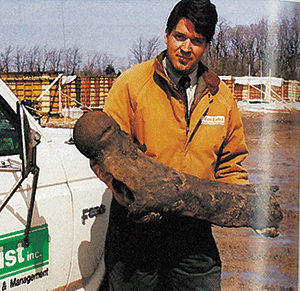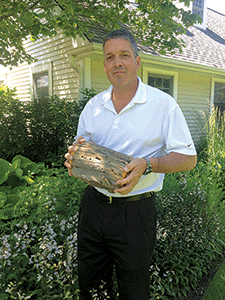
David Van Zelst recalls the discovery of a lifetime.
In spring 1992, Van Zelst Inc. employees in Wadsworth, IL were digging an irrigation pond on the landscape company’s property when one of them made a surprising discovery.
“It was the last day, the last hour of the dig, which had taken about three weeks,” recalls company president David Van Zelst. “We pulled out an item, and we had no idea what it was. We literally had no idea what it was.”
Since the company was situated on a route once used by Ringling Bros. Circus, Van Zelst thought the item might be something from a traveling circus.
But as Landscape Management wrote in its June 1992 issue, it turned out to be something far more exotic — the femur bone of a mastodon. Mastodons were elephant-like mammals that roamed North America during the Ice Age. They stood about 10 feet high and weighed up to six tons.
The leg bone the Van Zelst crew excavated was nearly four feet long. And as they kept digging, they discovered yet more mastodon bones and the perfectly preserved remains of an ancient spruce forest.
“We pulled out lots and lots of pieces that we nearly walked right over,” Van Zelst marvels.

The identification
After making the discovery, Van Zelst contacted the Illinois State Museum in Springfield, IL. The following day, a team of scientists led by the museum’s curator of geology, Dr. Russell Graham, arrived and quickly identified the bones. The scientists estimated that the bones were more than 10,000 years old.
“We were excited, but not surprised, because it’s moderately common to find mammoths and mastodons in old bogs,” recalls Graham, now the director of the Earth and Mineral Sciences Museum at Penn State University.
Graham and his team were curious about what caused the extinction of the mastodons. Ten thousand years ago, Illinois was likely a tundra. So the mastodons’ extinction could have been caused by global warming or the movement of vegetation in the region, Graham theorizes.
In the limelight
“It was tons of fun,” Van Zelst recalls of the discovery. “You know, you get three minutes of fame in your life, and that was my minute-and-a-half of fame.”
Indeed it was. In the 24 hours immediately following the discovery, the media swarmed the Van Zelst property. And the publicity continued. “I didn’t get anything done for two weeks because we were doing interviews,” Van Zelst says. “It was a lot of fun and absolutely fascinating.”
A photograph of Van Zelst holding a thick mastodon thigh bone was aired on late-night TV shows. “There are a lot of sexual connotations that came up with the bone,” Van Zelst laughs. “You can imagine.”
Final stops
Since Van Zelst didn’t have the materials necessary to store the bones and logs, the company kept only a few small pieces. It donated some of the logs to Arizona State University and about 70 bones to the Illinois State Museum, which had the means to preserve them.
The bones still are being stored at the Illinois museum today. Jeff Saunders, Ph.D. the museum’s current curator of geology, says besides the preserved spruce trees, the Van Zelst dig unearthed bones from two mastodons, including the femur, a tusk, a pelvis, vertebrae and ribs. The dig also uncovered deer and bison bones and a cottontail bunny’s thigh bone, Saunders says.
For Van Zelst Inc. today, life — and business — goes on. The company specializes in design/build projects in Chicago’s northern suburbs and southeastern Wisconsin. Much of the company’s 75-person staff is the same as it was in 1992.
“We’re about the same size in number of people, but we have more clients,” Van Zelst says. Lately, he adds, “our clients’ moods have gotten better and people are starting spend again.”
Even as Van Zelst’s 33-year-old business continues to move forward, that 1992 irrigation project seems as close to him as yesterday. “It was a ton of fun,” he says. “It was a great life experience.”
Photos: David Van Zelst
